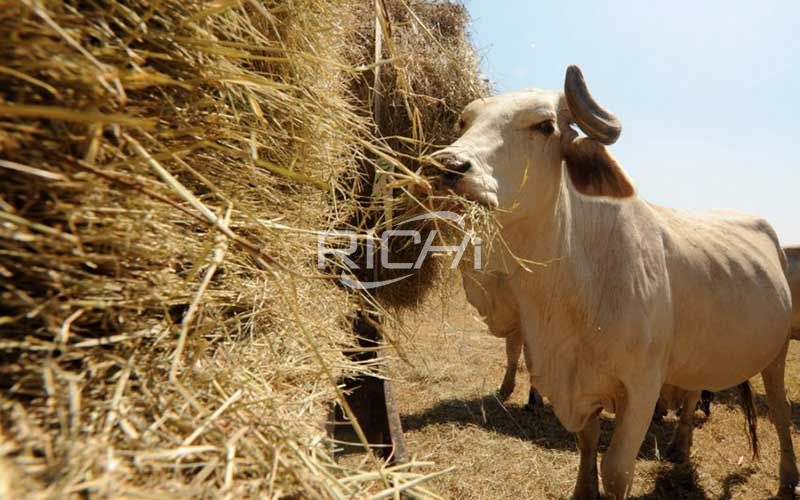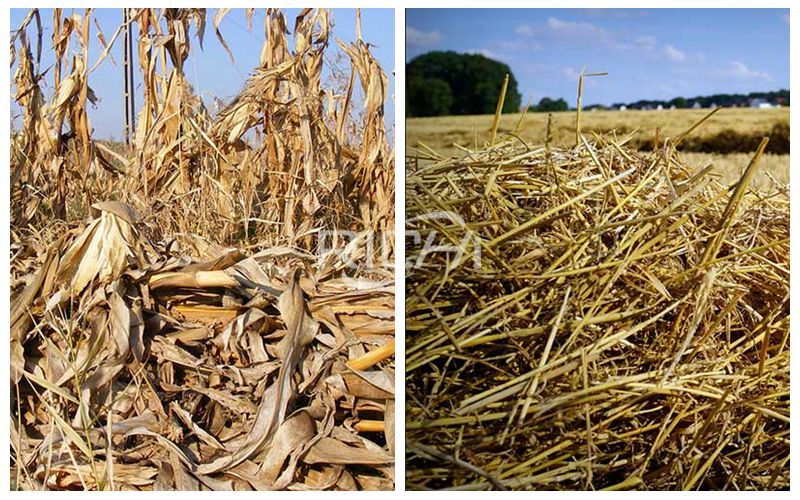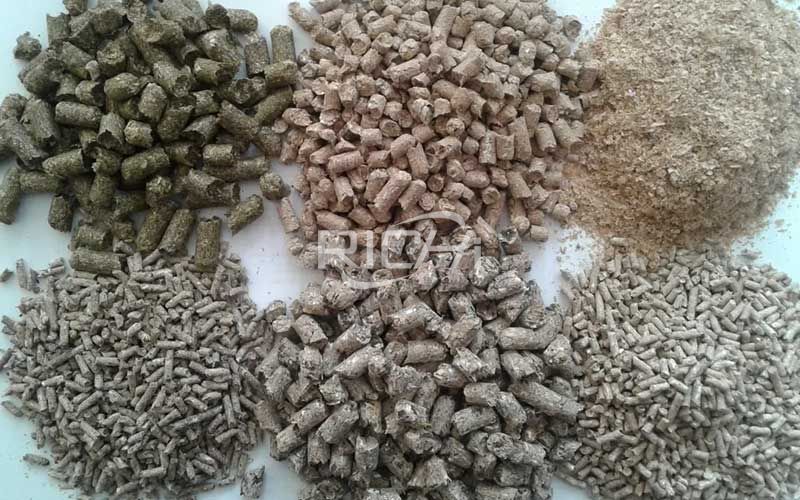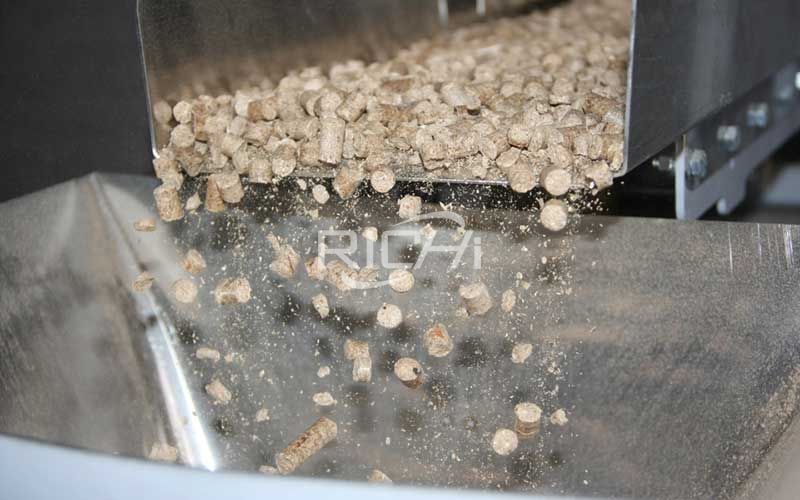
This is where you find all our press releases and news articles.
My country is rich in straw resources. According to statistics, the country’s annual output of various crop straws amounts to 600 million tons, accounting for 20% to 30% of the world’s total straw output, and its amount is equivalent to more than 50 times the amount of grass cut in the northern grasslands. At present, domestic crop stalks are used for feedstuffs. In my country, only 6%-8% of meat is converted from grass, while the United States accounts for about 73%, and Australia accounts for about 90% of meat converted from grass. This shows that my country's straw resources still have great potential for utilization.

cattle eat straw
Looking at the development trend of the world feed industry, the processing and utilization of roughage such as straw is playing an increasingly important role in the feed industry. This is mainly because:
1. Coarse fodder such as straw has abundant reserves and low price, and the proportion of processed and utilized is small at present;
2. Ruminants and other herbivorous livestock, which account for a large proportion of animal husbandry, feed on forage grass and certain roughages;
3. As the demand for feed grains in various countries continues to grow, leading to a shortage of feed grains. This forces people to try to use coarse fodder and straw to develop animal husbandry, and give priority to the development of herbivorous livestock.
Straw feed is the remaining stalks and leaves of crops after harvesting seeds. Its crude fiber content is as high as 30-50%, protein is 2-8%, and crude ash content is above 6%. The content of other vitamins except vitamin D is extremely low. It is a type of large volume, poor palatability, and low nutritional value. Roughage with low digestibility. However, straw feed has a wide range of sources, types, quantities, and low prices. It contains more than half of the energy accumulated by plant photosynthesis. As a non-competitive feed resource, as long as it can be processed and modulated reasonably to increase its digestibility The ingestion amount used to feed livestock and poultry, especially to feed ruminant livestock such as cattle and sheep, can still become a high-quality feed source.

Corn stalk and wheat stalk
Since the first introduction of pellet feed production technology in 1930, pelleting has become one of the most common processes in feed processing. Compared with powdered materials, granular materials have the advantages of nutritional factors and non-nutritive factors:
1. Such as reducing dust, preventing the occurrence of reclassification of feed components during transportation, etc., so as to ensure the balanced intake of nutrients for animals and prevent picky eaters;
2. Increase animal feed intake by improving the palatability of feed, while saving the time and energy consumption required for animal feeding;
3. Through high temperature treatment of granulation, pathogenic microorganisms can be killed; in addition, packaging and transportation costs or storage space can be reduced.
The particle size depends on two factors. One is the feeding behavior of the animal, for example, piglets prefer small pellets; the other is the production efficiency of the pelletizer. The use of a large diameter and thinner ring mold to produce pellets is efficient. Low energy consumption. Reports on the effect of particle size on pig growth performance are rare. Helodevverson (1996) fed growing-finishing pigs with pellets processed by ring molds with diameters of 3.1mm, 3.9mm and 4.8mm. The results showed that the diameter of the die hole was 3.1mm. Traylor et al. (1996) reported that the particle size (2mm, 4mm, 8mm and 12mm) had almost no effect on the growth performance of weaned piglets from day 0 to day 5, but during the period from day 29 to finishing, 4mm particles had a positive effect on ADG. Effect, FCR increased by 4%. Peter (1998) summarized the Danish pig feed processing experience and concluded that for pigs of different ages, 2.5mm can be widely accepted, but the particle diameter of the piglet feed is 2mm. Hancock et al. (1999) believe that a single particle diameter of 4mm-5mm is more suitable for pig feed, which can significantly save the time for replacing the ring die and the investment for the ring die.

Different size pellets
1. The use of straw pellet compound feed to raise livestock, through the digestion of animals to return the straw to the field, reduce the amount of chemical fertilizers, reduce the chemical residues of crops, increase the soil organic matter content, and enhance its water permeability, which can promote a virtuous cycle of agricultural production and make While increasing agricultural production, reduce production costs.
2. In the process of high-temperature extrusion and granulation, the raw materials are matured and some bacteria can be killed, so that the straw pellet compound feed has good palatability, livestock chews, feed intake increases, digestion and absorption rate and feeding efficiency are greatly improved. Concentrated feed is pelletized by adding straw powder to increase the comprehensive utilization rate by more than 30%;
3. The volume of straw is compressed by nearly 8 times after granulation, and it becomes "compressed biscuits" for cattle and sheep, which is convenient for transportation and storage, greatly reducing food transportation costs, and is not easy to mold in summer, fire and flame retardant, which is the strategic reserve of feed and disaster prevention reserve. The best way.
Domestic market: According to relevant statistics, a cow needs 10 kg of roughage per day, and a sheep needs 3.3 kg of roughage per day. Our country needs about 800 million tons of roughage every year. The grassland degradation in our country is very serious. The grassland area in the 1990s was only 50% of the 1960s. The number of herbivorous livestock increased every year, while the grassland area decreased year by year, resulting in a shortage of roughage in my country. Only in Ximeng, Inner Mongolia Autonomous Region In 2000, there was a shortage of 3 million tons of forage grass. With the improvement of people's living standards, the demand for milk continues to increase. Large and medium cities across the country are vigorously developing the dairy industry, and there is a great demand for roughage. The domestic market is vast, and the demand for roughage is stable, and it is increasing year by year.

Production of straw pellet feed
International market: Some resource-poor countries in the world, such as Japan, South Korea, Singapore and the Middle East, need to import large amounts of hay and feed grains every year to meet the needs of their domestic animal husbandry. The Hokkaido region of Japan alone needs 5.5 million tons of roughage every year, and now it mainly relies on imported hay from the United States and Australia to make up for the shortage of roughage, while the price of hay in the United States and Australia is more expensive. In some countries in the Middle East, such as Israel and Saudi Arabia, due to traditional customs, animal husbandry is to raise herbivorous poultry. The Middle East is a desert area where forage grass is extremely scarce. They also rely on imported roughage to support their animal husbandry. Straw feed has a quality similar to that of hay, but the price is cheaper than hay in the United States and Australia, and is easily accepted by these countries and regions.
At present, the factor affecting the development of scale and standardization of cattle and sheep is the problem of forage. In the past, farmers used their own feed to raise cattle and sheep, and the general idea was that they could only raise cattle and sheep if they had grass. To completely solve this problem, it is necessary to commercialize forage feed. If the straw biological pellet feed is promoted, it can solve the problem of large-scale and standardized feeding of forage for cattle and sheep. The straw biological pellet feed is small in size, low in moisture content, convenient for packaging, convenient for storage and transportation, and convenient for fire prevention; it is not easy to deteriorate and is convenient to feed. It can be used as commercial forage feed for farmers. Large-scale and standardized feeding farms process this feed to feed cattle and sheep. The ratio of feed and meat (milk) will be reduced, which will not increase the cost, but will also increase benefits due to the increase in feed nutrients, changes in feed formulations, and increased labor productivity .
In recent years, straw biological pellet feed has been approved by more and more breeding plants and exported to South Korea and Japan. With the continuous development of animal husbandry, the number of cattle and sheep has increased dramatically, and the demand for straw biological pellet feed will also increase. As a commercial feed, straw biological pellet feed will play a positive role in promoting the growth and development of animal husbandry. Therefore, it is an inevitable trend for cattle and sheep to feed straw biological pellet feed.
Having the right mix of reliable, high-quality pellet machine and pelletizing systems and expert support is essential to your success. Watch how our end-to-end feed pellet plant solutions have helped our customers optimize their performance.
Our customized and future-proofed turnkey pellet plant solutions is designed with you at the core. From vision to reality and beyond, our team stays connected with yours. Giving you peace-of-mind with an expert at your side.

At RICHI, we go beyond project completion. With RICHI Servicee, we’re your dedicated partners in success. Count on us for expert guidance, minimal downtime, and optimized productivity. Choose RICHI for unmatched service and support.



Meet global product demands and quality standards with industry-leading pellet plant design, engineering, equipment, and construction services for pellet processors.


Your Partner Beyond Project Completion
2000+ cases
RICHI is the leading designer, manufacturer and builder of pellet plants in the world, completing over 2000 projects in 140 countries across 6 continents.
Read More
Increase plant productivity, profitability, and safety by integrating high quality equipment into your pellet production line. Over the years, RICHI has become China's top pellet equipment manufacturer. At the same time, RICHI has established valuable partnerships with the world's leading component and raw material manufacturers to bring you the best there is in technology, automation, and efficiency in pelleting plant machinery.

For nearly 30 years, RICHI has been providing best-in-class pellet plant equipment and services to clients across a variety of industries, sizes, and needs. We pride ourselves on the knowledge and skill that each team member possesses – from our technical sales team to our process design engineers. You can count on RICHI Machinery to take your operation to the next level of innovation, quality, and success.
Need help with your pellet manufacturing plant project? Contact us today.
ANIMAL FEED
BIOMASS
WOOD
ORGANIC FERTILIZER
AQUA FEED
CAT LITTER
MUNICIPAL WASTE RECYCLING
SPECIAL PELLET PRODUCTION
RICHI Machinery continues to deliver world class pellet mill equipment, pellet plant engineering and project solutions that add value to our customers in the animal feed, wood waste, agriculture waste, organic fertilizer, cat litter and special pellet products industries. Throughout the years, we RICHI Machinery have built strong brand, becoming industry-leading pellet machine manufacturer. We value integrity, promise quality, and prioritize your success.
Learn MoreWith our expert team, we precisely implement your process engineering requirements in pellet mill and pelletizing plant systems. No matter which industry you’re in – we understand your needs and deliver solutions that meet the highest standards.
At RICHI, quality comes first. Our pellet making machine and related pellet line equipment undergo rigorous quality controls to ensure they meet the highest standards. Rely on products that are durable, safe, and efficient.
With decades of experience in pellet machine and pellet production line production, we have earned a reputation as a trusted partner in various industries. Our expertise allows us to cover a wide range of applications.
Not only do we offer premium pelleting equipment, but we are also experts at designing, building, installing, and maintaining facilities from the ground up. Our expertise is within pellt plant process design, discovering the most efficient, productive, and profitable way to handle your materials in an end-to-end cycle.

Keeping in touch with us is an effective way to solve all your problems. If you have any needs or questions, please leave your contact information, then RICHI technical consultants will send design, quotation, videos to your mailbox. You can also contact us directly via WhatsApp: +86 13838389622
Copyright©2015-2024 by HENAN RICHI MACHINERY CO., LTD. All rights reserved.